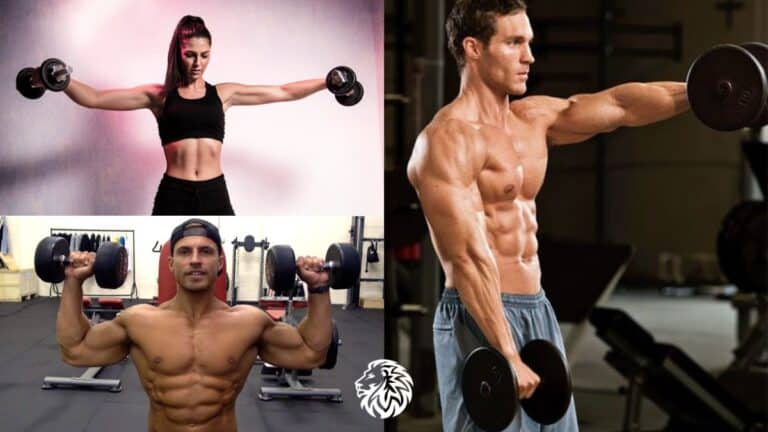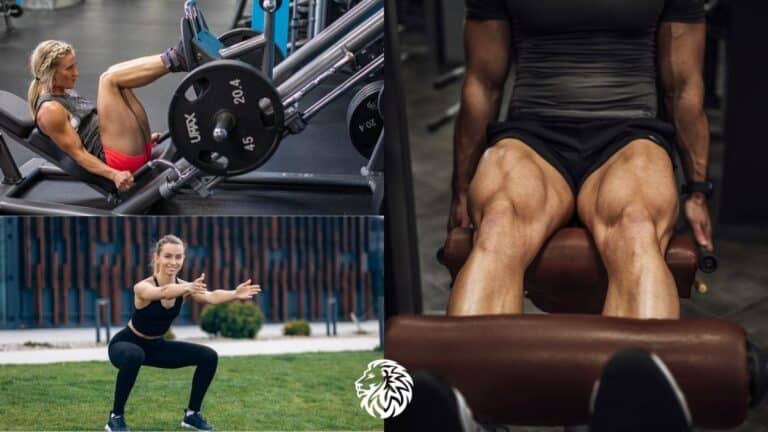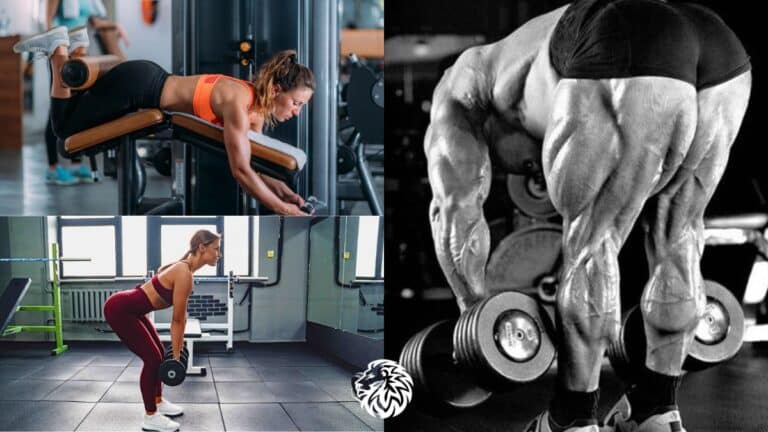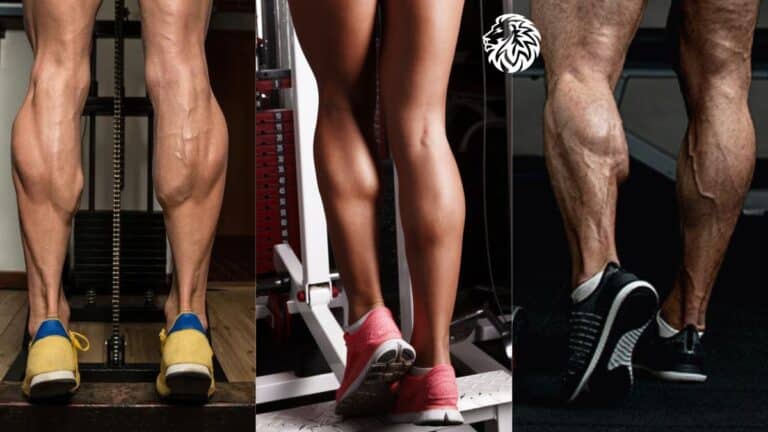Stronger, larger biceps are more than just a symbol of strength and fitness; they play a crucial role in both functional daily activities and in enhancing overall physical appearance. Biceps, being a prominent muscle group in the arms, are often considered a benchmark of one’s strength and fitness level. From a practical standpoint, well-developed biceps assist in lifting and carrying objects, contributing to better functional strength which is essential in both daily tasks and various sports. Aesthetically, bigger biceps shape the upper arm and are often associated with a more toned and fit body image, boosting self-confidence and presence.
But how does one effectively and safely achieve this goal of bigger biceps? This article aims to demystify the process, breaking it down into 10 easy-to-follow steps. Whether you’re a beginner or have been training for some time, these steps will guide you through essential practices, from workout techniques to lifestyle changes, ensuring you’re on the right path to not just enhancing the size of your biceps, but also improving their strength and overall health. Let’s embark on this journey to achieve the strong, well-defined biceps you desire.
Understanding Bicep Anatomy and Function
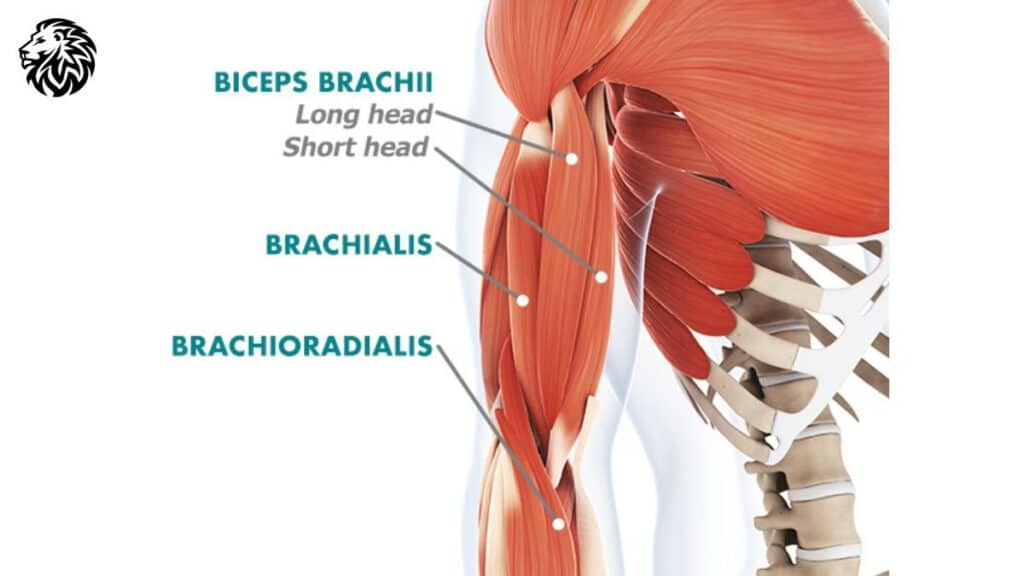
The biceps brachii, commonly known as the biceps, is a two-headed muscle located on the upper arm between the shoulder and the elbow. This muscle comprises two parts: the long head and the short head. The long head is located on the outer part of the arm, while the short head is found on the inner part. Both heads originate from different points on the scapula (shoulder blade) and converge into a single muscle belly, attaching to the forearm. The primary function of the biceps is to flex the elbow and rotate the forearm. Additionally, the biceps assist with shoulder flexion.
Adjacent to the biceps is the brachialis, an underlying muscle that also contributes to elbow flexion. The brachioradialis, a muscle of the forearm, plays a role in this motion as well.
Understanding the anatomy and function of these muscles is crucial for designing effective bicep workouts. Knowing the specific roles of each muscle head, for instance, can guide you in selecting exercises that target different parts of the biceps for balanced development. For example, exercises like hammer curls and reverse curls engage the brachialis and brachioradialis, contributing to overall arm development and enhancing the appearance of the biceps.
Furthermore, recognizing that bicep muscles are involved in various movements beyond just curling helps in incorporating a variety of exercises. This not only prevents workout monotony but also ensures comprehensive muscle growth and strength. Effective bicep workouts, therefore, should not only focus on isolation exercises like curls but also include compound movements that engage multiple muscle groups, offering a balanced approach to arm development.
Bigger Biceps in 10 Easy Steps
Step 1: Setting Realistic Goals
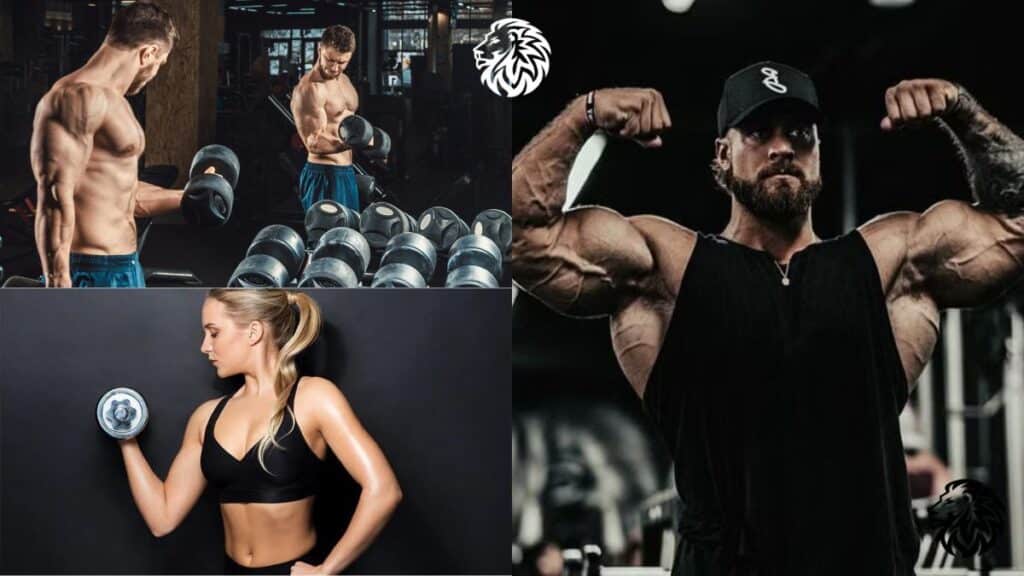
Setting achievable goals is fundamental in any fitness journey, especially when aiming to increase bicep size. Realistic goal-setting helps in creating a sense of direction and purpose, providing clear targets to work towards. This approach not only keeps you motivated but also helps in tracking progress effectively, allowing for adjustments in your training and nutrition plans as needed.
When setting goals for bicep growth, it’s important to be realistic about the results you can achieve within a certain timeframe. Muscle growth, or hypertrophy, is a gradual process influenced by various factors including genetics, training intensity, nutrition, and rest. A common, realistic goal for muscle growth is gaining about 0.5 to 1 pound of lean muscle per month, though this can vary individually.
To set practical goals for bicep growth, consider the following steps:
- Assess Your Starting Point: Understand your current bicep size and strength. This helps in setting a baseline to measure progress against.
- Define Specific Targets: Rather than a vague goal like “get bigger biceps,” set specific targets such as increasing your bicep circumference by a certain number of inches or enhancing the weight you can curl by a certain amount.
- Establish a Timeline: Set a realistic timeline for your goals. Remember, muscle growth takes time, so a period of several months to a year might be a realistic timeframe for noticeable changes.
- Consider Your Lifestyle: Factor in your overall lifestyle, including work commitments, nutrition, and rest. Ensure your goals are achievable within your daily routine.
- Prepare for Plateaus: Understand that progress might not always be linear. There will be periods where your growth seems to stall – these are normal and can be addressed with adjustments in your training.
- Seek Professional Guidance: If you’re unsure about how to set realistic goals, consulting a fitness professional can provide valuable insights and help tailor goals to your individual needs.
By setting realistic and specific goals for bicep growth, you can maintain a focused and motivated mindset, making your fitness journey both enjoyable and effective.
Step 2: Proper Nutrition

Nutrition plays a pivotal role in muscle building, including the growth of biceps. The right balance of nutrients not only fuels your workouts but also aids in recovery and muscle repair, leading to growth. Understanding and implementing proper nutritional habits is key to achieving your bicep-building goals.
- Protein Intake: Protein is the building block of muscle. Aim to consume a source of high-quality protein with every meal. This includes lean meats like chicken, turkey, and fish, as well as plant-based options like tofu, lentils, and beans. The general guideline for muscle building is to consume around 1.6 to 2.2 grams of protein per kilogram of body weight per day.
- Carbohydrates for Energy: Carbohydrates are crucial for providing the energy needed for intense workouts. Focus on complex carbs such as whole grains, fruits, vegetables, and legumes, which offer sustained energy release.
- Healthy Fats: Don’t shy away from fats; they’re essential for hormone production, including those related to muscle growth. Incorporate sources of healthy fats like avocados, nuts, seeds, and olive oil into your diet.
- Stay Hydrated: Adequate hydration is essential for overall health and can impact workout performance and recovery. Aim to drink at least 8 cups of water a day, more if you are engaging in intense exercise.
- Meal Timing: Consider the timing of your meals in relation to your training. Eating a meal rich in protein and carbs post-workout can aid in muscle recovery and growth.
- Avoid Empty Calories: Limit intake of foods high in sugar and poor in nutritional value. These can lead to unnecessary weight gain and don’t contribute to muscle growth.
- Supplements: While whole foods should be your primary source of nutrients, supplements like whey protein, BCAAs (Branched-Chain Amino Acids), and creatine can support muscle growth and recovery.
- Consistency Is Key: Consistent, daily adherence to your nutrition goals is crucial for seeing results. Occasional indulgences are fine, but overall, try to stick to your nutrition plan.
Remember, individual nutritional needs can vary based on factors like age, gender, weight, height, and level of physical activity. It may be beneficial to consult with a nutritionist or dietitian to create a personalized eating plan aligned with your muscle-building goals.
Step 3: Adequate Hydration

Hydration is a crucial, yet often overlooked, element of muscle health and growth. Water plays numerous vital roles in the body that directly and indirectly impact muscle development.
- Transport of Nutrients: Water is essential for the transportation of nutrients to the muscles. Proper hydration ensures that the proteins and carbohydrates necessary for muscle repair and growth are efficiently delivered to your muscle cells.
- Joint Lubrication: Adequate hydration helps maintain the lubrication of joints. This is crucial for weightlifting and other exercises that put stress on the joints, as it helps prevent injuries that could hinder your workout routine and muscle growth.
- Temperature Regulation: During exercise, your body temperature increases. Water helps regulate body temperature through sweating. Overheating can lead to decreased performance, early fatigue, and even heat-related illnesses, all of which can negatively impact your workout and muscle-building capabilities.
- Facilitation of Digestion: Water aids in digestion, ensuring that the body can break down foods and absorb nutrients effectively. These nutrients are vital for muscle repair and growth.
- Elimination of Waste Products: Staying hydrated helps the body remove waste products created during intense workouts, like lactic acid, which can hinder muscle growth and recovery if not efficiently eliminated.
- Enhancing Muscle Recovery: Proper hydration can aid in muscle recovery post-exercise. Dehydrated muscles can become more prone to cramps and stiffness, which can delay the recovery process.
- Optimizing Workout Performance: Dehydration can quickly lead to fatigue, reduced motivation, and decreased physical performance. Even a small dip in hydration levels can impact your strength, power, and endurance.
The general recommendation is to drink at least 8 cups of water per day, but this amount increases with physical activity. A good practice is to drink water before, during, and after your workouts. Additionally, paying attention to the color of your urine can be a practical way to monitor your hydration status – aim for a light, straw-like color.
In summary, maintaining adequate hydration is essential for overall health and plays a significant role in muscle growth and recovery. Regular and sufficient water intake should be an integral part of any fitness regimen focused on building muscle.
Step 4: Warm-Up Exercises

Warming up before any workout, including those targeting the biceps, is crucial to prevent injuries and enhance performance. A proper warm-up increases blood flow to the muscles, raises body temperature, and prepares the muscles, tendons, and joints for the physical stress of weightlifting. This not only helps in reducing the risk of strains and sprains but also improves muscle elasticity and joint mobility, leading to a more effective workout.
Effective warm-up exercises for bicep workouts include:
- Light Cardio: Start with 5-10 minutes of light cardiovascular exercises like jogging in place, jumping jacks, or using a skipping rope. This increases overall body temperature and blood flow.
- Dynamic Stretching: Incorporate dynamic stretches that involve movement, helping to loosen up the muscles and joints. Arm circles, shoulder shrugs, and arm swings are good examples. These exercises should be performed in a controlled manner to gently stretch the biceps, triceps, and shoulder muscles.
- Activation Exercises: Engage in exercises that specifically target the arms and shoulders to prepare them for the workout ahead. This can include exercises like band pull-aparts or light dumbbell curls with minimal weight.
- Specific Warm-Up Sets: Before jumping into your heavy lifting sets, start with a set or two using lighter weights. For example, if you plan to do bicep curls, start with a weight that’s about 50% of the weight you’ll use in your working sets. Perform a higher number of repetitions (10-15) to get the blood flowing to the biceps.
- Wrist and Forearm Stretches: Since these areas are integral to bicep exercises, it’s important to warm them up as well. Simple stretches like extending the arm and gently pulling back on the fingers can help.
- Mind-Muscle Connection: Use the warm-up phase to also mentally prepare for the workout. Focus on the muscles you will be working on and mentally rehearse your movements.
A well-executed warm-up should leave you feeling alert, agile, and ready to tackle your bicep exercises with reduced risk of injury and improved performance. Remember, a warm-up is an integral part of your workout, not just an optional add-on.
Step 5: Bicep-Specific Workouts

To effectively target and grow your biceps, incorporating a variety of exercises is key. Each exercise hits the biceps in slightly different ways, promoting comprehensive development. Here are some foundational bicep-specific exercises, along with instructions and tips for proper form:
- Standard Bicep Curls:
- How to Do It: Stand with your feet shoulder-width apart, holding a dumbbell in each hand at arm’s length. Keep your elbows close to your torso and palms facing forward. Curl the weights while keeping your upper arms stationary, exhale as you lift the dumbbells to shoulder level. Lower the weights back down slowly.
- Tips: Focus on moving only your forearms. Avoid swinging your body to lift the weights; the movement should be controlled and originate from your biceps.
- Hammer Curls:
- How to Do It: Similar to the standard curl, but with the palms facing each other. Hold the dumbbells at your sides, palms facing in. Curl the weights while keeping your upper arms stationary, breathe out as you lift. Slowly lower back down.
- Tips: This exercise targets the brachialis and brachioradialis muscles in addition to the biceps, providing a more complete arm workout.
- Concentration Curls:
- How to Do It: Sit on a bench with your legs spread. Pick up a dumbbell in one hand, and rest your elbow against your inner thigh. Keep your arm extended, then curl the dumbbell towards your shoulder. Lower it back after a short pause.
- Tips: Keep your back straight and avoid swinging the weight. This exercise isolates the biceps effectively, so focus on the muscle contraction.
- Preacher Curls:
- How to Do It: Use a preacher bench and hold a dumbbell or a barbell with both hands. Extend your arms, then curl the weight towards your chin. Lower it slowly back down after a pause.
- Tips: This exercise prevents cheating and is excellent for isolating the biceps.
- Incline Dumbbell Curls:
- How to Do It: Lie back on an incline bench with a dumbbell in each hand, arms extended. Curl the weights while keeping your upper arms stationary, exhale as you lift. Slowly lower the weights back down.
- Tips: The inclined position stretches the biceps more, offering a unique tension angle.
- Cable Bicep Curls:
- How to Do It: Stand in front of a cable machine with the handle attached at the lower setting. Hold the handle with your palms facing up and curl the weight towards your shoulders.
- Tips: The continuous tension provided by the cable offers a different stimulus to the biceps.
Remember, proper form is more important than the weight lifted. Using too heavy weights can lead to poor form, reducing the effectiveness of the exercise and increasing the risk of injury. Start with lighter weights, focusing on muscle engagement and form, and gradually increase the weight as you become stronger.
Step 6: Incorporating Compound Movements
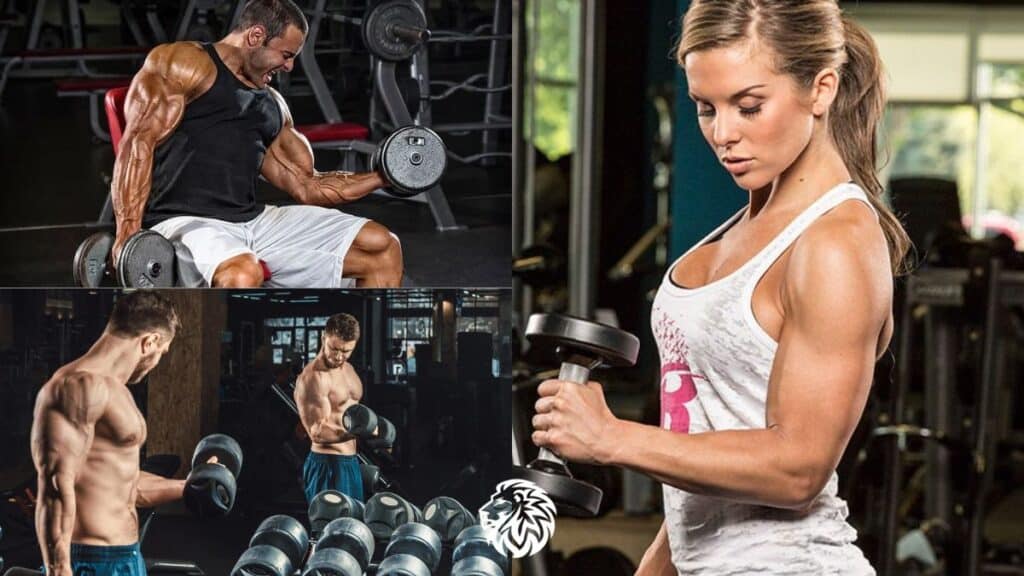
While isolation exercises like curls are important for targeting the biceps directly, incorporating compound movements into your workout routine can significantly enhance bicep development. Compound exercises involve multiple joints and muscle groups, offering several benefits for overall muscle growth, including the biceps.
- Increased Hormonal Release: Compound movements stimulate the release of growth hormones and testosterone, which are vital for muscle growth. These hormones have a systemic effect on the body, benefiting muscle groups worked directly and indirectly, including the biceps.
- Pull-Ups and Chin-Ups:
- Effect on Biceps: Both pull-ups and chin-ups engage the back and shoulder muscles, but they also heavily involve the biceps, especially chin-ups where the palms face towards you.
- How to Perform: Hang from a bar with hands shoulder-width apart (pull-ups) or closer (chin-ups), and palms facing away (pull-ups) or towards you (chin-ups). Pull your body up until your chin is over the bar, then lower back down.
- Benefits: These exercises not only improve upper body strength but also apply significant stress to the biceps, aiding in their development.
- Rows (Barbell, Dumbbell, or Cable):
- Effect on Biceps: Rows primarily target the back but also involve the biceps due to the pulling motion.
- How to Perform: Hold the weight with both hands, bend at your hips and knees, and keep your back straight. Pull the weight towards your torso, then slowly lower it back.
- Benefits: Rows help in building overall pulling strength, which indirectly contributes to bicep size and strength.
- Deadlifts:
- Effect on Biceps: While primarily a lower body and back exercise, deadlifts engage the biceps as stabilizers during the lift.
- Benefits: This exercise helps in building overall body strength, which can translate to improved performance in bicep-specific exercises.
Incorporating these compound movements into your routine offers a balanced approach to muscle building. They not only enhance overall strength and muscle mass but also indirectly stimulate the biceps, contributing to more robust and comprehensive arm development. Additionally, compound exercises can improve functional strength, which is beneficial for daily activities and sports. Remember to maintain proper form and balance these with bicep-specific exercises for optimal results.
Step 7: Rest and Recovery

Rest and recovery are as crucial as the workout itself for muscle growth, including the development of biceps. Muscles grow during the recovery period, not while you are working out. Here’s why rest days are essential and some advice on active recovery methods:
- Muscle Repair and Growth:
- During exercise, muscle fibers undergo stress, leading to microscopic tears. The repair process of these fibers during rest is what leads to muscle growth.
- Without adequate rest, the muscle doesn’t have time to repair and grow, potentially leading to overuse injuries.
- Preventing Overtraining:
- Overtraining can lead to fatigue, decreased performance, and even injury. Rest days help prevent this by allowing the body time to recuperate.
- Symptoms of overtraining include prolonged muscle soreness, irritability, and a plateau or decline in performance.
- Rest Day Frequency:
- The frequency of rest days depends on the intensity of your workouts. Typically, it’s recommended to have at least 48 hours of rest between intense workouts targeting the same muscle group.
- Beginners might need more frequent rest days, while experienced lifters may require fewer.
- Active Recovery Methods:
- Active recovery involves doing low-intensity exercise to stimulate blood flow to the muscles without putting them under much stress. This can speed up the removal of lactic acid and recovery nutrients transportation.
- Examples include light walking, cycling, yoga, or a gentle swim.
- Stretching and Mobility Work:
- Engaging in stretching and mobility exercises on rest days can improve flexibility and reduce muscle tightness, enhancing muscle recovery and growth.
- Focus on full-body stretching, paying extra attention to the arms and shoulders.
- Adequate Sleep:
- Sleep is vital for muscle recovery. Aim for 7-9 hours of quality sleep per night, as growth hormone levels, crucial for muscle repair, are elevated during sleep.
- Nutrition on Rest Days:
- Maintain a balanced diet even on rest days. Your body needs nutrients to repair and build muscle.
- Stay hydrated and consider maintaining your protein intake to support muscle repair.
Remember, rest and recovery are when the magic of muscle growth happens. Listen to your body, and don’t hesitate to take additional rest if needed. Balancing workout intensity with adequate rest and recovery is key to sustained muscle growth and overall health.
Step 8: Progressive Overload

Progressive overload is a fundamental concept in strength training and muscle building. It involves gradually increasing the demands on the musculoskeletal system to continually make gains in muscle size, strength, and endurance.
- Understanding Progressive Overload:
- The principle of progressive overload states that in order to grow stronger and bigger, you must continually increase the demands you place on your muscles. This can be done by lifting heavier weights, increasing the number of repetitions or sets, improving your form, or adjusting the tempo of your exercises.
- Simply put, your muscles will not grow or become stronger unless they are forced to adapt to a tension that is above and beyond what they have previously experienced.
- Importance in Muscle Building:
- Without progressive overload, muscles will adapt and become efficient at handling the stress, leading to a plateau in growth and strength.
- By continuously challenging your muscles, you encourage ongoing hypertrophy (muscle growth) and improvements in muscle strength and endurance.
- Tips for Safely Increasing Workout Intensity:
- Incremental Increases: Increase the weight you lift by small increments, such as 2-5% at a time. This helps avoid injury and allows your muscles to adapt.
- Vary Reps and Sets: Consider increasing the number of repetitions or sets for a given exercise. For example, if you’re comfortably doing 3 sets of 10, try 3 sets of 12.
- Enhance Your Technique: Improving your form can also create a new challenge for your muscles. Focus on slower, more controlled movements.
- Change Exercise Routines: Incorporating different exercises targeting the same muscle group can stimulate growth by challenging the muscles in new ways.
- Alter Rest Periods: Reducing the rest time between sets can increase the intensity of your workout and challenge your muscles and endurance.
- Track Your Progress: Keep a workout log to track increases in weights, reps, sets, and any changes in your routine. This not only helps in planning progressive overload but also in monitoring your growth over time.
Remember, while the goal is to increase the intensity of your workouts, it should be done methodically and with attention to your body’s signals. If you experience excessive fatigue or pain, it could be a sign of overtraining or injury, necessitating a reassessment of your approach to progressive overload. Listen to your body and ensure you’re pairing increased intensity with adequate nutrition and rest for optimal results.
Step 9: Tracking Progress

Monitoring progress is a crucial aspect of any fitness regimen, particularly when working towards specific goals like increasing bicep size. Tracking progress helps in maintaining motivation, adjusting your training and nutrition plans as needed, and provides a tangible record of your improvement over time. Here are some effective methods for tracking progress:
- Workout Logs:
- Keeping a detailed log of your workouts is essential. Record the exercises, weights, sets, and reps for each session.
- Note any changes in your workout routine, such as increases in weight or variations in exercises.
- Reviewing your workout logs can help identify patterns, areas for improvement, and how close you are to achieving your goals.
- Progress Pictures:
- Take regular progress pictures in consistent lighting and from multiple angles. This can visually document changes that might not be noticeable day-to-day.
- Compare these pictures over time to visually assess increases in muscle size and overall body composition changes.
- Body Measurements:
- Measure the circumference of your biceps and other areas of your body regularly. This provides quantitative data on your muscle growth.
- Use a flexible tape measure and ensure consistency in how tight you pull the tape.
- Strength Improvements:
- Keep track of the weights you lift and the number of repetitions you perform. Increasing strength is a good indicator of muscle growth.
- Tracking strength improvements can also help in planning progressive overload strategies.
- Physical and Health Indicators:
- Pay attention to how you feel. Improvements in energy levels, reduced fatigue, and feeling stronger are good indicators of progress.
- Monitoring your overall health, including sleep patterns and mood, can also provide insights into your fitness journey.
- Digital Apps and Tools:
- There are numerous fitness apps available that can help in tracking workouts, nutrition, and even taking and storing progress photos.
- Some apps also allow you to set reminders and goals, offering a more interactive and guided approach to tracking.
- Consistency in Tracking:
- Consistency is key when tracking progress. Choose a regular interval for taking measurements, photos, and assessing your strength, like weekly or monthly.
Remember, progress can sometimes be slow and is not always linear. There will be periods of rapid improvement and times when it feels like you’re not making much progress. By keeping track of your journey, you can stay motivated and make informed decisions about any necessary changes to your training or lifestyle to continue moving towards your goals.
Step 10: Patience and Consistency

Achieving larger, stronger biceps, like any fitness goal, requires a commitment to patience and consistency. Muscle growth is a gradual process, and it’s important to stay focused and persistent in your efforts.
- Understanding the Process:
- Muscle growth doesn’t happen overnight. It’s a slow and steady process that requires ongoing dedication.
- Recognize that everyone’s body responds differently to exercise due to factors like genetics, age, and previous training experience.
- Consistency is Key:
- Regular workouts and adherence to your nutrition and rest routines are essential for seeing results. Skipping workouts or frequently changing routines can hinder progress.
- Consistent effort, even on days when you’re not feeling 100%, is what leads to long-term success.
- Dealing with Plateaus:
- Plateaus, where progress seems to stall, are a normal part of any fitness journey. They do not signify failure but are rather a sign to reassess and potentially alter your approach.
- If you hit a plateau, look into varying your workouts, adjusting your diet, or increasing rest.
- Avoiding Burnout:
- While consistency is important, so is listening to your body. Overtraining can lead to burnout and injury.
- Balance your training with adequate rest and recovery to maintain long-term progress.
- Learning from Setbacks:
- Setbacks, whether due to injury, life circumstances, or other reasons, are inevitable. What matters is how you respond to them.
- Use setbacks as learning experiences and opportunities to reassess and strengthen your commitment to your goals.
- Celebrating Small Victories:
- Acknowledge and celebrate the small milestones along the way. This could be lifting heavier than before, consistent training for a month, or just feeling stronger and healthier.
- These small victories are stepping stones to your larger goals.
- Seeking Support:
- Don’t hesitate to seek support from fitness communities, personal trainers, or friends and family. A support system can provide motivation and advice.
Remember, the journey to larger biceps and improved fitness is a marathon, not a sprint. Patience, persistence, and a positive mindset are your greatest allies. Keep pushing forward, stay consistent in your efforts, and trust the process – your hard work will pay off in time.
Conclusion
Building bigger, stronger biceps is a journey that combines various elements, each playing a crucial role in your overall success. Remember these key points as you embark on this journey:
- Understand the Basics: Knowledge of bicep anatomy and the function of related muscle groups is fundamental. It informs your exercise choices and technique.
- Set Achievable Goals: Establish realistic and specific goals for your bicep growth. This helps in maintaining focus and measuring progress.
- Prioritize Nutrition: Proper nutrition fuels muscle growth. A balanced diet rich in protein, healthy fats, and complex carbohydrates is essential.
- Stay Hydrated: Adequate hydration is vital for overall health and optimal muscle function.
- Warm-Up Properly: Warming up prevents injuries and prepares your muscles for intense workouts.
- Incorporate a Variety of Exercises: A mix of bicep-specific exercises and compound movements ensures comprehensive arm development.
- Rest and Recover: Giving your muscles time to rest and repair is just as important as the workouts themselves.
- Practice Progressive Overload: Gradually increase the intensity of your workouts to continue making gains.
- Track Your Progress: Regularly monitoring your progress keeps you motivated and on track.
- Be Patient and Consistent: Muscle growth takes time and consistent effort. Stay committed and patient.
Now, armed with this knowledge, you’re ready to start your journey towards achieving stronger, bigger biceps. Remember, the path to reaching your fitness goals is unique to you. It will have its challenges, but with perseverance and dedication, you’ll see the fruits of your labor. Embrace the process, celebrate your progress, and most importantly, enjoy every step of your journey to a stronger, healthier you. Let’s lift those weights and make those gains!

